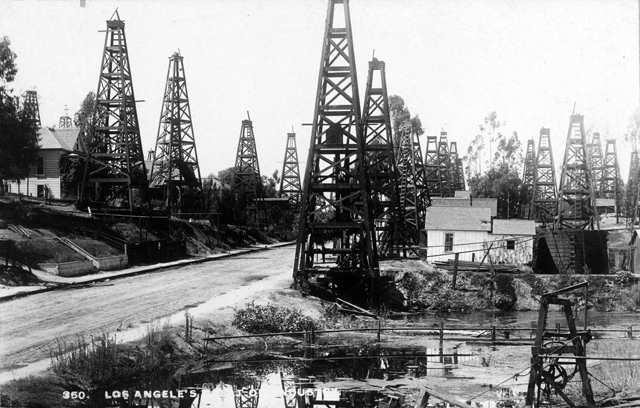Most climate change gases can be traced to just 90 companies
Oil is pumped out of the Belmont Oil Field near Los Angeles in this photo by an unknown photographer in the late 1800s.
A new study finds that just 90 companies have created most of the global-warming gases that humans have added to the Earth's atmosphere. A report by the Climate Accountability Institute in Colorado analyzed records going back more than two hundred years.
Rick Heede led the team for the Institute. He says his group wanted to trace all the industrial emissions that have contributed to climate change — by going back generations and attributing the emissions to the companies that originally extracted the fossil fuels from the ground.
They started with current rates of emissions and pollution and applied the numbers to historic production figures published by the companies. All of that took a lot of time digging through annual reports, often kept only in dusty research libraries — some dating back to 1900 or even earlier. Then they had to determine the carbon value of all that oil, gas and coal. It was especially tricky with coal, where the carbon content varies based on the type of coal extracted.
Then they had to adjust their numbers, to remove the fossil fuels that weren't burned, but used for other purposes, such as in lubricants.
"We wanted to deduct for the carbons stored in long-lived products and just focus on tracing the emissions in the atmosphere back to the fuels produced," Heede says. "For these 90 entities — that we call carbon majors, 81 of which are investor- or state-owned corporations — they have produced 63 percent of all the carbon emitted to the atmosphere since 1751."
The largest sources of climate-change pollutants were Chevron and Exxon Mobil, followed by Russia's Gazprom, Saudi Aramco, Shell and BP, roughly in that order, he added. All told, the top 10 companies account for about 13 percent of emissions. All 90 companies are listed in this interactive chart from The Guardian.
Heede and his team tried to account for all of the mergers and acquisitions that the fossil fuel industry has gone through over the years. That means that many emissions attributed to today's companies were produced by a range of once-independent companies that were sold to the current major players.
"We did trace some of the emissions back to companies whose assets upon dissolution, like British Coal, we weren’t able to trace to existing companies, but almost all of these companies are still in existence," he says.
Heede points out that while 90 companies seems a small number, it's even more striking to think about the leadership of these companies. He says the top executives and directors of these 90 companies are few enough to fit on two Greyhound buses.
"I think they can have a vast positive influence on how we deal with climate change. We have to seize the opportunity now to get their help in solving the problem as opposed to just being passive and profitable bystanders to continued climate destabilization," Heede says. "I think shareholders will all notice which of these companies become leaders in the climate change arena and which become laggards."
Every day, reporters and producers at The World are hard at work bringing you human-centered news from across the globe. But we can’t do it without you. We need your support to ensure we can continue this work for another year.
Make a gift today, and you’ll help us unlock a matching gift of $67,000!
